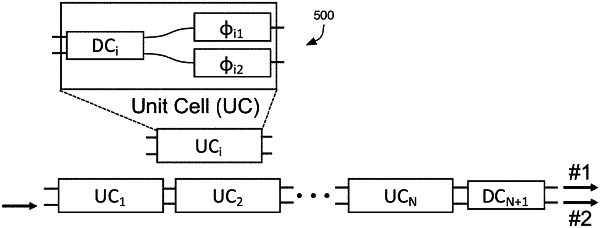| CPC G02B 6/29355 (2013.01) [G02B 6/12007 (2013.01); G02B 6/2935 (2013.01); G02B 6/2938 (2013.01); G02B 6/29368 (2013.01); H04B 10/505 (2013.01); H04B 10/67 (2013.01); H04J 14/02 (2013.01); H04J 14/0209 (2013.01); H04J 14/0282 (2013.01); H04B 10/40 (2013.01)] | 9 Claims |

|
1. A method for fabricating a wavelength division multiplexing (WDM) filter for multiplexing or demultiplexing optical waves at wavelengths within different respective channels, the method comprising:
fabricating a first frequency shaping unit comprising:
two or more series-cascaded unit cells, each unit cell comprising a 2×2 coupler that cross couples two input ports to two output ports according to a predetermined coupling ratio connected to a phase delay component that imposes a relative phase delay between two paths according to a predetermined phase difference; and
fabricating a second frequency shaping unit comprising:
two or more series-cascaded unit cells, each unit cell comprising a 2×2 coupler that cross couples two input ports to two output ports according to a predetermined coupling ratio connected to a phase delay component that imposes a relative phase delay between two paths according to a predetermined phase difference;
wherein a first set of two or more frequency shaping units, including the first frequency shaping unit, have an associated spectral response with a first spacing between adjacent passbands, and the relative phase delays and coupling ratios of the first frequency shaping unit are selected based at least in part on material and modal refractive index dispersion to provide at least one substantially flat passband in the spectral response associated with the first frequency shaping unit; and
wherein a second set of two or more frequency shaping units, including the second frequency shaping unit, have an associated spectral response with a second spacing between adjacent passbands that is twice the first spacing, and the relative phase delays and coupling ratios of the second frequency shaping unit are selected based at least in part on material and modal refractive index dispersion to provide at least one substantially flat passband in the spectral response associated with the second frequency shaping unit.
|